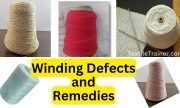What is Sizing?
The process of applying a protective adhesive coating upon the yarn’s surface is known as sizing. In this article, I will brief advantage and disadvantage of sizing process. Sizing process is crucial to attain the maximum weaving efficiency for natural or blended yarns, particularly as the sizing operation is the most important operation. By increasing the elasticity, strength, weight, smoothness, and frictional resistance of yarns, sizing process increases the weaving efficiency. Sizing has has advantage and disadvantage.
Objectives of Sizing:
- To improve warp yarn’s weaving ability.
- Maintaining good fabric quality by reducing hairiness, weakness, and increasing smoothness, strength.
- To increase the breaking strength of cellulose yarns.
- In order to increase the elasticity.
- In order to remove the fibers that are projecting.
- For synthetic or blended yarns, to reduce electrostatic formation.
It is vital to understand the significance of sizing and its role in producing high-quality woven fabrics before exploring the advantages and disadvantages of sizing process in textile manufacturing. Warp dressing, also called sizing or warp dressing, is a crucial preparation process that involves applying a protective coating known as “size” to the warp yarns before weaving. It improves the yarn handling characteristics during weaving, enhances weaving efficiency, and ensures better fabric quality.
Advantage of Sizing:
Some important advantage of sizing process is described below:
- Removes projecting fibers: Sizing reduces protruding fibers on the yarn surface, resulting in a smoother and more uniform yarn.
- Maintains fabric quality: By adhering sizing materials to yarn consistently, sizing ensures the desired fabric quality, resulting in improved weaving efficiency and fabric quality.
- Reduces electrostatic formation: Static electricity is reduced during weaving when sizing is used in blended or synthetic yarns.
- Enhances weaveability: Sizing improves the weaveability of warp yarns, reducing the risk of breakage during the weaving process.
- Reduces yarn hairiness: Sizing reduces yarn hairiness, resulting in smoother, more refined fabrics.
- Increases breaking strength: Sizing increases the breaking strength or tensile strength of cellulose yarns, improving fabric durability.
- Increases yarn elasticity: Sizing increases warp yarn elasticity, enabling it to adapt to different weaving patterns.
- Enhances yarn smoothness: Sizing contributes to the smoothness of warp yarns, resulting in an even and appealing fabric surface.
- Reduces yarn weakness: Sizing reduces the weakness of warp yarns, making them less prone to breakage and defects.
- Protects yarn from abrasion: Sizing provides a protective coating to yarn, reducing abrasion and wear during weaving.
Disadvantage of Sizing:
Here, some disadvantage of sizing process is described below:
- Capital investment: For small businesses, sizing requires considerable upfront investment in machinery and equipment.
- Labor-intensive: The sizing process involves labor-intensive processes that require skilled workers.
- Cost of size ingredients: Sizing materials and chemicals can affect the profitability of weaving by increasing production expenses.
- Long preparatory process: Sizing preparation, including yarn preparation and chemical mixing, can take time and increase production lead times.
- Deterioration of yarn quality: Poor sizing techniques and low-quality sizing materials can affect yarn quality and fabric performance.
- Less yarn per inch due to increased diameter: When yarn diameter is increased, the yarn count or yarn per inch may decrease, which may affect the fabric’s intended specifications.
- Rough surface of warp: An uneven application of size solution may result in a rough surface on the warp yarns, increasing friction and potentially causing weaving problems.
- Reduce yarn extension percentage: Sizing can limit a yarn’s stretchability and flexibility by reducing its extensibility.
- Increase yarn stiffness: Sizing can stiffen the yarn, affecting the drape and feel of the fabric.
- More power to drive loom: Sized yarns are heavier and more resistant, which may require more power to drive the loom.
- Less length of yarn on warp loom: Sized yarns can take up more space on the warp beam, reducing the length of yarn that can be wound.
- Difficulties of size removal: The removal of sizing after weaving can be time-consuming and challenging.
- Variation in dye take-up: Residues from sizing can affect dye absorption, resulting in uneven coloration.
- Cost of desizing: Additional costs are incurred during the desizing process.
- Increased pollution: Environmental pollution may result from chemical or solvent-based sizing processes.
In spite of these disadvantages, sizing remains a critical part of textile manufacturing to ensure efficient weaving and high quality fabrics. In order to optimize fabric production and achieve desired fabric properties, manufacturers must carefully consider the advantages and disadvantages of sizing and implement appropriate sizing techniques.
You may read:
- Definitions of sizing, objectives and impact on warp yarn.
- Why sizing is called heart of weaving.
- Primary and Secondary Size Ingredients.
- Characteristics of Good Size Ingredients.
- Types and Techniques of sizing.
- Working Principle of Slasher Sizing Machine.
- Size Cooking Equipment.
- Drying Methods in Sizing Process.
- Modern Control System of Sizing Machine.
- Sizing faults







Right